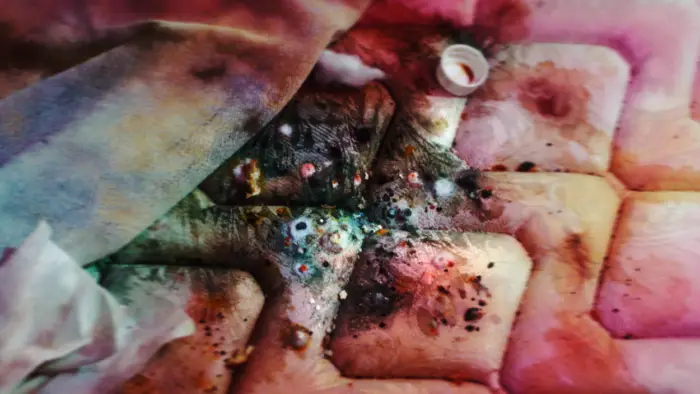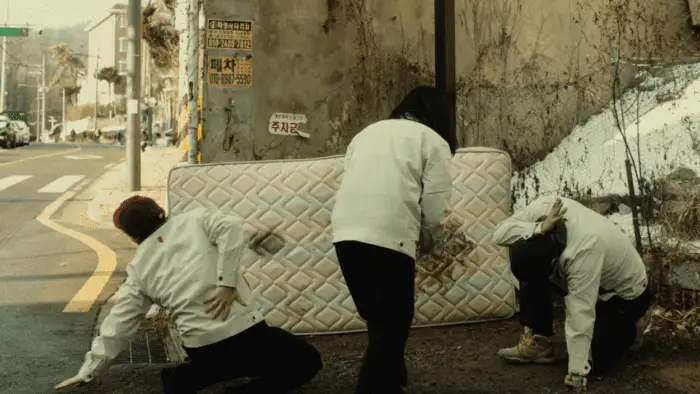Part of what I love about a good genre film is its ability to work within identifiable constraints yet tell a story that is refreshingly—or in cases like this, disgustingly—new. The very concept of genre is one based on replication, but that replication has to adapt and evolve or risk dying out. In the case of The Fifth Thoracic Vertebrae, a new Korean film from first-time director Syeyoung Park, the situation itself is not unfamiliar: a foreign entity takes root in a familiar abode, its own need for survival threatening its host’s. But Park manages to take a basic sci-fi/body horror conceit and create something ineffably weird and gorgeous from it in this impeccable little jewel of an arthouse genre film.
I have watched some impressively tactile and olfactory films in recent memory, ones that immersed you in such an elaborate mise en scène you could practically feel and smell your way through their strange environments: After Blue: Dirty Paradise, Tin Can, Moon Garden, Mad God among them. None of these has anything on the beautifully smelly, damp, moldy The Fifth Thoracic Vertebrae, a film whose title would seem to have little to do with its protagonist.
Indeed, it may not make much sense to dispense with any plot summary. Park’s film is, simply, not about the plot. An onscreen title sets the action in wintry Gangbuk-gu in 2000, “538 days before birth.” A young woman (Gyeol, played by Moon Hyein) arrives too late at her new apartment to supervise the moving company delivering her mattress: they’ve left it in the snowy street. Gyeol moves the mattress in herself as boyfriend Yoon (Haam Seokyoung) sleeps.
As the months pass, the mattress develops a funk. A mold, a fungus, something growing in it. As the couple sleep on it, the mold grows into sentience, seeking sustenance, seeming to find it in the young woman, especially. While she sleeps it feasts—on its victim’s vertebrae. Its nourishment comes from the satisfying crunch of bones and snap of sinew, it growing stronger with each meal. Even on the film’s transparently modest budget, Park manages to create an evocative, immersive, and impressively disgusting monster-of-a-mattress, using extreme close-ups and an array of squishing, crunching, grinding Foley effects to convey the creature’s feasting. Black, moldy spores grow on the mattress as it undulates with life.

As the couple breaks up and leaves the apartment, the mattress—and the living fungus within it—is cast out, sold, reused, resold, abandoned, and reclaimed by others, each of whom becomes a new host to the creature’s needs. There’s always someone, it seems, who can reuse a mattress by covering up its defect. Onscreen titles continue to chart the days after birth as they grow in number into the hundreds, by the end of the film even the thousands. Each host seems desperate in their own way, isolated from their loved ones or distancing themselves from emotional connection. The creature, even as it feasts on them—focusing on that vital fifth thoracic vertebrae as its main course—displays some empathy for its victims even as its reign is terrifying.

At just an hour long, Park’s feature is something of an oddball genre experiment to be sure. It’s hard to take some of its more clichéd moments entirely seriously, and for as impressive as the bare-bones effects are, they don’t always work. Sometimes the screen is simply full of squishy goo. But nonetheless, The Fifth Thoracic Vertebrae is an impressive and innovative debut, even just on the merits of its clever genre play and elaborate mise en scène.
More importantly, though, Park’s film, as strange as it is, feels curiously connected to our current human condition. The coronavirus pandemic isolated us from our loved ones and left us in agonizing worry about our preparedness for future pandemics. The moldy fungus that grows in a modest mattress in The Fifth Thoracic Vertebrae feasts on its hosts’ loneliness and thrives as humans fail in their efforts to identify, understand, or control it. Isn’t that exactly the boat we find ourselves in today, an environment changing in ways we don’t fully understand and don’t control, our isolation from each other preventing us from rehabilitative, restorative action?

In a time of concerning climate change, of environmental catastrophe, of uncontrollable pandemics, this little film about a moldy mattress will not only impress and enthrall. It will also register with anyone empathetic to concerns about the planet’s, about humanity’s future. The Fifth Thoracic Vertebrae may be all squick, muck, and mold onscreen, but like many a great horror/sci-fi film, it’s in how it connects to the current human condition that makes it tick.
Once you’ve seen it, Park’s film will give you plenty to think about as you lay down to your nightly sleep.
On your mattress.
And whatever it is that might be growing inside it.
The Fifth Thoracic Vertebrae makes its North American streaming debut on the SVOD service IndiePix beginning Oct. 20, 2023. Written and directed by Syeyoung Park. 64 minutes, in Korean, with English subtitles.




